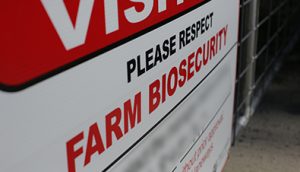Read the latest information on
Foot-and-mouth disease
 On-farm biosecurity has always been important, yet over the last few years its implementation has become far more visible. This serves the producer by keeping them aware of and managing people moving onto and about their property, and the associated risks.
On-farm biosecurity has always been important, yet over the last few years its implementation has become far more visible. This serves the producer by keeping them aware of and managing people moving onto and about their property, and the associated risks.
A more recent issue we’ve seen is activists who have, in several high-profile cases nationwide, taken it upon themselves to enter properties without consent in order to bring attention to their opposition to livestock farming.
“Willful trespassers can obviously pose a biosecurity risk, but it’s difficult to mitigate when you don’t know when or where someone might turn up,” said Animal Health Australia’s Executive Manager for Biosecurity and Product Integrity, Dr Simon Humphrys.
When dealing with people movement onto your farm, it’s important to consider the risks that person poses, that is, the likelihood they are unwittingly carrying a disease, pest or weed. That generally depends on where they’ve come from.
“Regardless of who is entering the property, there’s always a chance that they’re bringing in a problem, which is why you need to conduct a risk assessment, however brief and informal,” said Dr Humphrys.
“If they’ve been in production zones or handling livestock – or they’ve recently been overseas – they pose a greater risk and need to be treated accordingly.”
Limiting the ways in which people can access the property, by shoring up fencing, locking gates, and communicating your entry procedure through signage, can all help to minimise the risk posed by visitors, remembering you can reduce risk but rarely eliminate it.
“Nothing will stop someone determined enough from entering the property,” Dr Humphrys explained.
“Biosecurity plans are a great place to start. Things like isolating livestock who’ve been in contact with visitors, and monitoring the areas they accessed for new pests and weeds, can be critical steps after a breach.”
It also pays to remember that biosecurity isn’t about locking down the property entirely. You’ll still need people to come and go. Utility companies and emergency services will also still have a legal right of access, so it’s really about focusing on zoning across your property and limiting risks into production zones.
In the case of unlawful access, however, the best course of action is to ask those people to leave, and phone the police if they do not.
“Several states and territories, supported by the Australian Government, have announced their intention to review biosecurity laws and regulations to increase penalties for people who invade farms, as a way of highlighting how important biosecurity can be for producers and whole agricultural industries,” Dr Humphrys said.
For more information on managing people movement on-farm, visit the People, Vehicles and Equipment section on the Farm Biosecurity website.